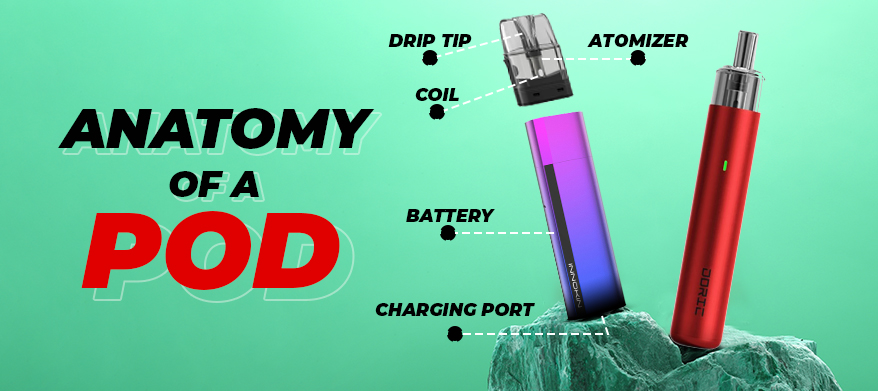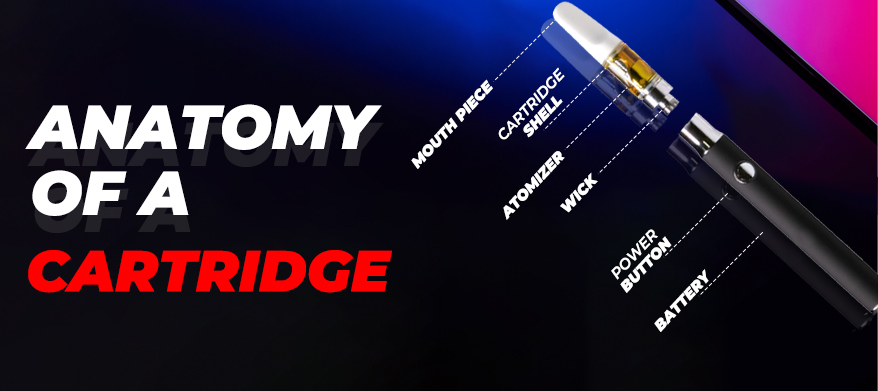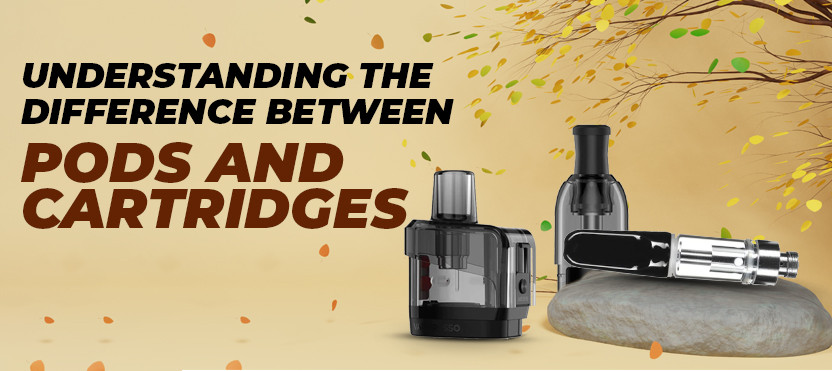Understanding the Difference Between Pods and Cartridges: A Comprehensive Guide
Definition of Pod and Cartridge
In the vaping industry, the terms pod and cartridge are often used interchangeably to refer to the part of a vape device that holds the e-liquid. A pod or cartridge usually consists of a mouthpiece, a tank that holds the e-liquid, and a heating element that vaporizes the juice.
Brief History of Pod and Cartridge
Pods and cartridges were first introduced to the vaping industry in the early 2010s as an alternative to the traditional tank and atomizer setup. The idea behind pods and cartridges was to create a simpler, more user-friendly vaping experience that didn't require users to manually refill their tanks or change out coils. The first pod systems were relatively low-powered and used nicotine salt e-liquids, which allowed for higher nicotine concentrations without the harsh throat hit. Since then, pod and cartridge systems have grown in popularity and now come in a wide variety of sizes, shapes, and designs to suit different vaping needs.
Anatomy of a Pod

A pod system consists of various components that club up to provide the perfect vaping experience. Let's have a look at the key components of a pod kit.
Pod Shell: The pod shell is the outer casing that holds all the other components of the pod. It can be made from a variety of materials, including plastic, metal, or glass. The shell also has a filling port that allows users to fill the pod with e-liquid.
Coil: The coil is the heating element inside the pod that vaporizes the e-liquid. It is usually made from a resistance wire, such as Kanthal, and is wrapped around a wick of cotton. When the pod is activated, the coil heats up and vaporizes the e-liquid.
Cotton or Wick: The cotton or wick is a porous material that sits inside the coil and absorbs the e-liquid. It allows the e-liquid to be delivered to the coil and vaporized. Some pods use traditional cotton wicks, while others use ceramic wicks that offer a longer lifespan and better flavor.
Mouthpiece: The mouthpiece is part of the pod that users inhale from.It can be made of a variety of materials, such as plastic, metal, or even ceramic. The mouthpiece also controls the airflow and the amount of vapor produced.
E-liquid Capacity: The e-liquid capacity of a pod varies depending on its size and design. For example; Some pods have a capacity of 1-2 ml, while others can hold up to 5 ml or more. The e-liquid capacity determines how often users need to refill the pod.
Airflow: The amount of vapor produced and the ease with which users can inhale it are determined by the airflow of a pod. Some pods have adjustable airflow, allowing users to tailor the draw resistance and vapor production to their liking. Other pods have a fixed airflow, which can be a simpler option for users who don't want to change their vaping experience.
Anatomy of a Cartridge

The anatomy of a cartridge is somewhat the same as a pod system but there are some altercations to its functioning. Let’s discuss the components of a cartridge in detail.
Cartridge Shell: Similar to a pod, the cartridge shell is the outer casing that holds all the other components of the cartridge. It can be made from a variety of materials, including plastic, metal, or glass. The cartridge shell also has a filling port that allows users to fill the cartridge with e-liquid.
Atomizer: The atomizer in a cartridge is the component that heats up and vaporizes the e-liquid. It consists of a heating coil and a wick, which absorb and vaporize the e-liquid. Some cartridges use replaceable atomizers, while others have built-in atomizers that are disposed of with the cartridge.
Wick: The wick in a cartridge is a porous material that absorbs the e-liquid and delivers it to the heating coil. It can be made from a variety of materials, including cotton, silica, or ceramic.
Mouthpiece: The mouthpiece in a cartridge is the part that users inhale from. It can be made of plastic, metal, or ceramic. The mouthpiece also regulates airflow and the amount of vapour produced.
E-liquid Capacity: Depending on the size and design of the cartridge, the e-liquid capacity can change. The liquid holding capacity of the cartridge depends on the ability to hold the liquid of the tank you are using or the model of the vape. The e-liquid capacity determines how often users need to refill the cartridge.
Airflow: The airflow of a cartridge impacts how much vapor is created and how easy users may consume it. Some cartridges offer adjustable airflow, which allows users to tune the draw resistance and vapor production to their preference. For customers who don't want to modify their vaping experience, other cartridges feature a fixed airflow, which can be a simpler alternative.
Types of Pods and Cartridges
Disposable
Disposable pods and cartridges are designed to be used once and then discarded. They are usually pre-filled with e-liquid and have a built-in battery and heating element. Once the e-liquid has been used up, the entire pod or cartridge is thrown away and replaced with a new one.
Refillable
Refillable pods and cartridges can be filled with e-liquid multiple times before they need to be replaced. They usually have a removable mouthpiece and a fill port that allows users to add e-liquid to the tank. Some refillable pods and cartridges have replaceable coils or atomizers, while others have built-in coils that are disposed of with the cartridge.
Pre-filled
Pre-filled pods and cartridges come already filled with e-liquid and are designed to be used until the e-liquid has been used up. They are usually disposable but can also be refillable. Pre-filled pods and cartridges are available in a wide range of flavors and nicotine strengths and can be a convenient option for users who don't want to mess with filling their e-liquid.
Compatibility
Compatibility is one of the most important factors involved in choosing the perfect device to vape. The most important factors to be kept in mind are; device compatibility, coil compatibility, and e-juice compatibility. Let’s discuss these factors in detail.
Device Compatibility
Pods and cartridges are designed to be used with specific devices. While some pods and cartridges are designed to be compatible with a wide range of devices, others are only designed to work with specific brands or models. It is important to ensure that the pod or cartridge is compatible with the device before using it.
Coil Compatibility
For refillable pods and cartridges, it is important to ensure that the coils or atomizers are compatible with the device. Some devices have proprietary coils or atomizers that are designed to work only with that device. Others have more universal compatibility and can use coils or atomizers from a variety of manufacturers.
E-liquid Compatibility
Not all e-liquids are compatible with all pods and cartridges. Some pods and cartridges are designed to work only with specific types of e-liquid, such as high VG or nicotine salt e-liquids. It is important to ensure that the e-liquid is compatible with the pod or cartridge before using it. Using an incompatible e-liquid can lead to poor performance, leaking, or even damage to the device.
Advantages and disadvantages of Pods and Cartridges
Pods and cartridges being two different systems, they bring along their own set of advantages and disadvantages. Let's look at the pros and cons of each and discuss them in detail.
Advantages
Convenience: One of the biggest advantages of using pod and cartridge systems is their convenience. They are very easy to use and require no special skills or knowledge. You simply insert the pod or cartridge into the device, and you're ready to go.
Portability: Pod and cartridge systems are very portable and easy to carry around. They are usually small and compact, making them ideal for traveling or for use on the go.
Reduced Maintenance: Pod and cartridge systems require less maintenance than traditional vaping devices. They don't need to be cleaned or maintained as frequently, making them a low-maintenance option for many vapers.
Consistency: Pod and cartridge systems are designed to provide a consistent vaping experience. This is because the e-liquid is pre-measured and pre-filled, ensuring that you get the same amount of e-liquid every time.
Flavor Variety: Pod and cartridge systems offer a wide range of flavors and nicotine strengths, giving you more options to choose from and allowing you to experiment with different flavors.
Disadvantages
Limited Customization: Pod and cartridge systems are designed to be simple and easy to use, which means that they offer limited customization options. You can't adjust the wattage or temperature, for example, which can limit your vaping experience.
Cost: Pod and cartridge systems can be more expensive than traditional vaping devices, especially if you're a heavy vaper. This is because the pods and cartridges need to be replaced frequently, which can add up over time.
Battery Life: Pod and cartridge systems often have smaller batteries than traditional vaping devices, which means that you may need to recharge them more frequently.
Environmental Impact: Pod and cartridge systems can be more environmentally damaging than traditional vaping devices, as they generate more waste. The pods and cartridges need to be disposed of after use, which can contribute to environmental pollution.
Availability: Pod and cartridge systems may not be as widely available as traditional vaping devices, which can make it difficult to find replacement pods or cartridges, especially if you live in a remote area.
Conclusion
In conclusion, pods and cartridges are both popular delivery systems for vaping devices, but they have significant differences in terms of design, compatibility, and performance. Pods are more versatile and offer more customization options, while cartridges are typically more straightforward to use. It's essential to consider your vaping needs and preferences before choosing between the two options. Additionally, it's important to keep in mind that both pods and cartridges require proper maintenance and care to ensure optimal performance and longevity. Overall, understanding the differences between pods and cartridges can help you make an informed decision when it comes to selecting the best delivery system for your vaping experience.
Explore Popular Articles
MFU SHISHA X2 Hookah 60K Disposable Vape: The Smart Choice for Long-Lasting Vaping
Buy Now The vaping landscape is continuously evolving, with innovation pushing the limits of comfort...
SMOK PRIV Bar Turbo 15,000 Puff Disposable Review : A Flavor-Packed Vape Experience
Buy Now Are you searching for a versatile and high-capacity disposable vape? Look no further than th...
Kong by Zilla x Jam Monster Vape Disposable (50000 Puffs): A Comprehensive Review
In a market flooded with disposable vape devices, only a few are truly standing out as revolutionary...
Nicotine Salts vs. Freebase Nicotine E-Liquids : Every Vaper Should Know
Nicotine salts are a form of nicotine combined with organic acids, allowing for smoother inhalation...





